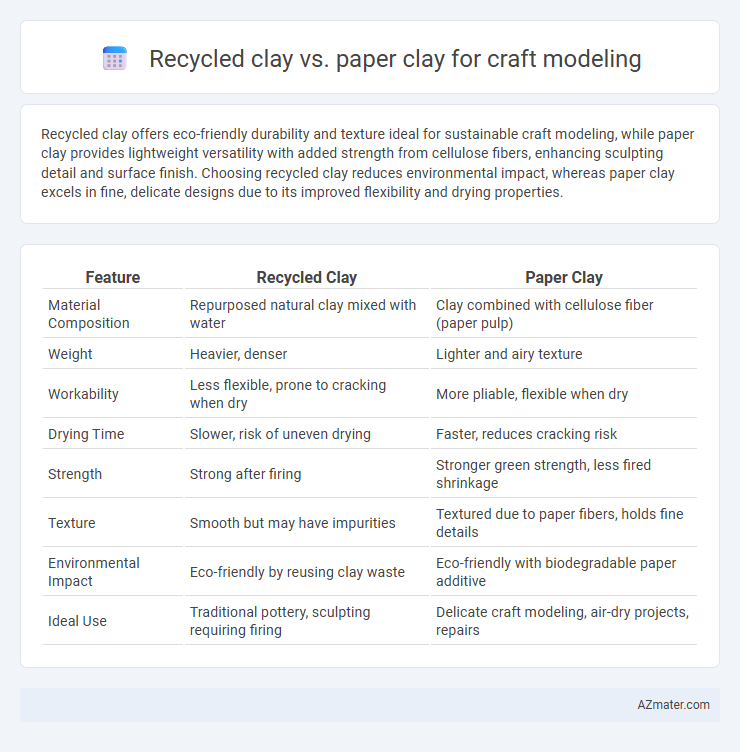Recycled clay offers eco-friendly durability and texture ideal for sustainable craft modeling, while paper clay provides lightweight versatility with added strength from cellulose fibers, enhancing sculpting detail and surface finish. Choosing recycled clay reduces environmental impact, whereas paper clay excels in fine, delicate designs due to its improved flexibility and drying properties.
Table of Comparison
| Feature | Recycled Clay | Paper Clay |
|---|---|---|
| Material Composition | Repurposed natural clay mixed with water | Clay combined with cellulose fiber (paper pulp) |
| Weight | Heavier, denser | Lighter and airy texture |
| Workability | Less flexible, prone to cracking when dry | More pliable, flexible when dry |
| Drying Time | Slower, risk of uneven drying | Faster, reduces cracking risk |
| Strength | Strong after firing | Stronger green strength, less fired shrinkage |
| Texture | Smooth but may have impurities | Textured due to paper fibers, holds fine details |
| Environmental Impact | Eco-friendly by reusing clay waste | Eco-friendly with biodegradable paper additive |
| Ideal Use | Traditional pottery, sculpting requiring firing | Delicate craft modeling, air-dry projects, repairs |
Introduction to Clay Types in Craft Modeling
Recycled clay and paper clay represent two popular mediums in craft modeling, each offering unique properties suited for different artistic needs. Recycled clay, made from reused earthen materials, provides an eco-friendly option with a dense, firm texture ideal for detailed sculpting and durable projects. Paper clay incorporates cellulose fibers, creating a lightweight, porous material that dries faster and allows for easier additions and repairs, making it a favorite for delicate and layered designs.
What is Recycled Clay?
Recycled clay is a sustainable modeling material made by processing and rehydrating previously used clay, reducing waste and lowering environmental impact in craft projects. It retains similar plasticity and workability to fresh clay while offering an eco-friendly alternative for artists and crafters. Compared to paper clay, which combines clay with cellulose fibers to increase strength and flexibility, recycled clay focuses primarily on repurposing existing clay materials.
What is Paper Clay?
Paper clay is a lightweight modeling material composed of traditional clay mixed with finely shredded cellulose fibers, which enhance its strength, flexibility, and drying properties compared to recycled clay. Unlike recycled clay, which primarily consists of reprocessed natural clay, paper clay offers superior workability, allowing for finer details and less cracking during drying and firing. Its unique fiber content enables artists to join dry and wet pieces seamlessly, making it ideal for complex craft modeling projects.
Key Differences Between Recycled Clay and Paper Clay
Recycled clay is primarily composed of previously used ceramic material that has been reprocessed, offering a denser texture and slower drying time ideal for robust sculpting projects. Paper clay incorporates cellulose fibers, making it lighter, more flexible, and less prone to cracking, which enhances workability and bonding of separate pieces. The drying behavior and surface texture differ significantly, with paper clay shrinking less and allowing for easier texturing compared to recycled clay's more traditional, firmer finish.
Workability and Texture Comparison
Recycled clay offers a denser texture with moderate workability, making it ideal for sturdy craft models that require solid shaping and minimal flexibility. Paper clay, infused with cellulose fibers, provides superior pliability and a lighter texture, enhancing ease of molding and fine detail work while also drying to a strong, lightweight finish. When comparing workability, paper clay allows for smoother sculpting and quicker repairs, whereas recycled clay is better suited for projects needing a more robust and less fragile material.
Drying Time and Shrinkage Rates
Recycled clay generally has longer drying times due to its higher moisture retention compared to paper clay, which dries faster because of its porous paper fiber content. Paper clay exhibits significantly lower shrinkage rates, often around 3-5%, whereas recycled clay can shrink up to 10-15%, increasing the risk of cracking during drying. These differences make paper clay preferable for detailed craft modeling requiring quicker handling and minimal deformation.
Strength and Durability Factors
Recycled clay offers enhanced strength due to its dense composition, making it ideal for heavy-duty craft modeling projects that require durability. Paper clay integrates cellulose fibers, resulting in a lighter material that dries harder but may be more prone to cracking under stress. Choosing between recycled clay and paper clay depends on the balance needed between impact resistance and fine detail retention in artistic creations.
Environmental Impact and Sustainability
Recycled clay significantly reduces environmental impact by minimizing waste and conserving raw materials, making it a sustainable choice for craft modeling. Paper clay incorporates recycled cellulose fibers, enhancing biodegradability and lowering energy consumption during production. Both materials support eco-friendly crafting by promoting resource efficiency and reducing landfill contributions.
Best Uses: Recycled Clay vs Paper Clay
Recycled clay is best suited for eco-friendly projects that capitalize on its durability and cost-effectiveness, making it ideal for sculptures and garden decorations requiring a solid structure. Paper clay excels in fine-detail modeling, lightweight sculptures, and delicate crafts due to its pliability, ease of sanding, and ability to adhere dry-to-dry surfaces. Artists prioritize recycled clay for robustness and sustainability, while paper clay is favored for intricate designs and mixed-media applications.
Choosing the Right Clay for Your Craft Project
Recycled clay offers an eco-friendly option with a heavier texture ideal for sturdy, large-scale craft modeling, while paper clay provides lightness and flexibility due to its paper fiber content, making it excellent for detailed, delicate projects. Consider the project's requirements for durability, weight, and drying time when choosing between recycled clay and paper clay to achieve optimal results. Selecting the right clay enhances the creative process and final appearance, ensuring your craft project meets both aesthetic and functional goals.

Infographic: Recycled clay vs Paper clay for Craft modeling
 azmater.com
azmater.com